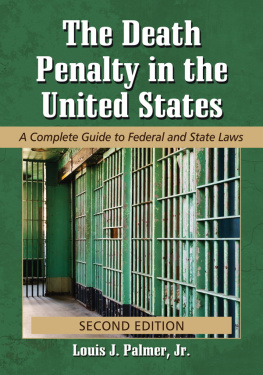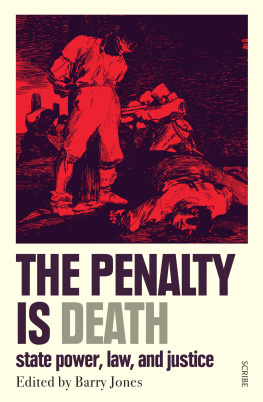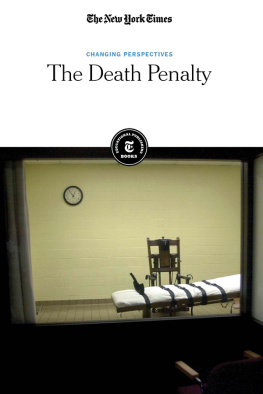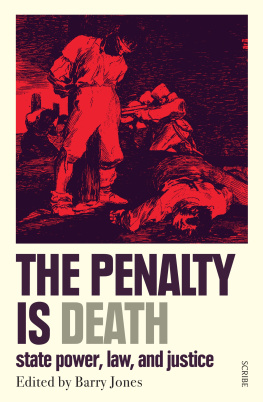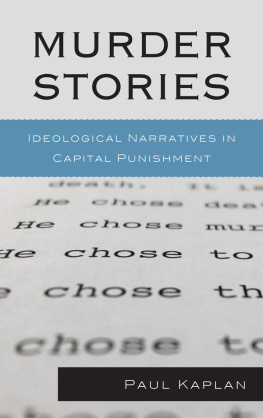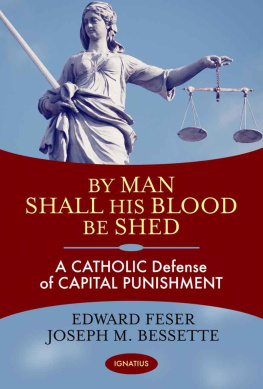
Also by Louis J. Palmer, Jr.,
and From McFarland
Encyclopedia of Capital Punishment in the United States, 2d ed. (2008)
Encyclopedia of DNA and the United States Criminal Justice System (2004, paperback 2013)
Organ Transplants from Executed Prisoners: An Argument for the Creation of Death Sentence Organ Removal Statutes (1999)
By Louis J. Palmer, Jr., and
Xueyan Z. Palmer
Encyclopedia of Abortion in the United States, 2d ed. (2009)
The Death Penalty in the United States
A Complete Guide to Federal and State Laws
Second Edition
Louis J. Palmer, Jr.

McFarland & Company, Inc., Publishers
Jefferson, North Carolina, and London
LIBRARY OF CONGRESS CATALOGUING DATA ARE AVAILABLE
BRITISH LIBRARY CATALOGUING DATA ARE AVAILABLE
e-ISBN: 978-1-4766-0579-1
2014 Louis J. Palmer. All rights reserved
No part of this book may be reproduced or transmitted in any form or by any means, electronic or mechanical, including photocopying or recording, or by any information storage and retrieval system, without permission in writing from the publisher.
Front cover image: death row in old prison (iStockphoto/Thinkstock)
McFarland & Company, Inc., Publishers
Box 611, Jefferson, North Carolina 28640
www.mcfarlandpub.com
List of Tables and Boxes
Chapter 1
Table 1.0: Executions in the U.S. 19301969
Chapter 2
Table 3.0: Modern Day Botched Electrocutions
Chapter 10
Box 10.0: Article 36 Vienna Convention on Consular Relations
Table 10.0: Foreign Nationals Executed 19762011
Chapter 11
Box 11.0: Capital Punishment Jurisdictions 2013
Table 11.0: Murder Time Clock 19992010
Table 11.1: Murder Circumstances by Relationship 2010
Table 11.2: Murder Weapon Used 20062010
Chapter 13
Table 13.0: Alternatives to Death Sentence for Conviction of Capital Offense
Chapter 14
Table 14.0: Murder Totals 20062010
Table 14.1: Aggravating Circumstances of Murder 20062010
Table 14.2: Gender of Victim of Aggravating Circumstances Murder 2010
Table 14.3: Average Annual Workplace Homicides 19931996
Table 14.4: Age of Victim That Constitutes an Aggravating Circumstance
Table 14.5: Age and Gender of Murder Victim 2010
Table 14.6: Other Murder Circumstances 20062010
Table 14.7: Gender of Victim of Other Murder Circumstances 2010
Chapter 15
Box 15.0: Penalty Phase Actors, Evidence and Consequences
Box 15.1: The Lockett Principles
Table 15.0: Age and Gender of Murderer 2010
Chapter 17
Box 17.0: Types of Trial Error
Chapter 21
Table 21.0: Juveniles Between the Ages 12 and 15 When Executed
Table 21.1: Inmates Executed Who Were Under 18 When They Committed Murder 19762003
Box 21.0: Court Systems
Chapter 22
Table 22.0: Average Time on Death Row Before Execution 20002010
Table 22.1: Death Row Inmates by Jurisdiction 2010
Chapter 23
Table 23.0: Family/Friends That May View Execution
Table 23.1: Media Representation at Executions
Chapter 24
Table 24.0: Methods of Execution Used During the Period 19772010
Table 24.1: Number of Executions, U.S. 19902010
Table 24.2: Execution Methods Used by Jurisdictions
Chapter 26
Table 26.0: Native Americans Executed 19762012
Chapter 28
Table 28.0: Preferred Punishments for Murder
Table 28.1: Characteristics of Death Row Inmates 2005
Chapter 29
Table 29.0: Median Costs for Defense Representation in Federal Capital Cases 19982004
Table 29.1: Tennessee Average Post-Conviction Defense Costs 19932003
Table 29.2: Indiana Costs for Murder Cases 20002007
Table 29.3: North Carolina Extra Expenditures for Death Penalty Cases 20052006
Table 29.4: Tennessee Average Number of Days from Offense Date to Sentence Date 19932003
Introduction
The death penalty landscape has changed considerably since the rst edition of this book was published in 1998. In the U.S. we no longer execute persons under age eighteen when they commit capital murder or those found to be mentally retarded; defendants have the right to a jury presiding over the penalty phase of a capital prosecution, and fewer states allow capital punishment. To address these and other substantive changes in death penalty law, the second edition of this book includes 13 new chapters.
Capital punishment is a complex and expensive form of retribution. It is also an emotionally charged punishment because of the risk of executing an innocent person, and the belief by some that it is a punishment with no purpose. This second edition, like the rst edition, is not intended to speak for or against the death penalty. Book shelves and Internet websites are saturated with advocates on both sides of the issue. This volume aims only to provide an objective review of how capital punishment works in the United States.
There is one qualication to the general theme. While some discussion is devoted to death penalty issues that arise before a defendant is convicted of a capital offense, the primary focus of the book is upon issues that are resolved after a defendant has been convicted of a capital crime. That aspect of capital punishment is the least understood by the general public.
On a more fundamental note, the reader should keep in mind that the United States is comprised of 52 sovereign legal jurisdictions: the 50 states, the federal government and the District of Columbia. All of these autonomous legal jurisdictions, tempered by the federal Constitution, make the death penalty a complex subject. Each jurisdiction has the authority, within the bounds of federal constitutional constraints, to design its own unique death penalty statutes. As a result of the majority of jurisdictions exercising their independent authority to create death penalty systems, no two death penalty systems are exactly the same in all particulars.
This book provides a comprehensive examination of the differences in death penalty systems in the nation. Not only will this book enable the reader to see the various distinct aspects of each jurisdictions death penalty system, but it will also aid the reader in understanding why these differences exist.
This book will also detail the factors common to each system. The reader will learn that many of these common factors exist because of decisions handed down by the United States Supreme Court.
In the nal analysis, the one constant that the reader will nd running throughout this book is the role of the Supreme Court. Through its interpretation of the Eighth Amendment of the Constitution, the Supreme Court has established many death penalty legal principles that are binding in all capital punishment jurisdictions.
The material in this book has been divided into six major parts. Part I, which contains ve chapters, lays out important foundational information. Chapter 1 provides a basic working knowledge of the common law origin of capital punishment in Anglo-American law. Chapter 2 builds on the previous chapter by exploring the impact of the Eighth Amendment on various specic death penalty issues. Chapter 3 examines the impact of the Double Jeopardy Clause and Ex Post Facto Clause on specic capital punishment issues. Chapter 4 looks at the meaning of a capital felons constitutional right to counsel and right to remain silent. Chapter 5 rounds out Part I by examining the American Bar Associations suggested defense team for a capital felon.
Next page
